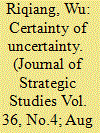|
|
|
Sort Order |
|
|
|
Items / Page
|
|
|
|
|
|
|
| Srl | Item |
| 1 |
ID:
183651


|
|
|
|
|
| Summary/Abstract |
China-U.S. inadvertent escalation has been a focus of recent international relations literature. The current debate, however, has not paid sufficient attention to two important factors: the survivability of China's nuclear forces under unintentional conventional attacks; and China's nuclear command, control, and communication (NC3) system. Based on detailed analysis of these two variables, three potential mechanisms of China-U.S. inadvertent escalation are examined: use-it-or-lose-it, unauthorized/accidental, and damage-limitation. Although the possibility of a major China-U.S. conventional war inadvertently escalating to a nuclear level cannot be excluded, the risk is extremely low. China's nuclear forces would survive U.S. inadvertent conventional attacks and, thus, are unlikely to be significantly undermined. Even though China's NC3 system might be degraded during a conventional war with the United States, Chinese leadership would likely maintain minimum emergency communications with its nuclear forces. Moreover, China's NC3 system is highly centralized, and it prioritizes “negative control,” which can help to prevent escalation. China's nuclear retaliatory capability, although limited, could impede U.S. damage-limitation strikes to some extent. To keep the risk of inadvertent escalation low, both sides must take appropriate precautions and exercise self-restraint in their planning and operations.
|
|
|
|
|
|
|
|
|
|
|
|
|
|
|
|
| 2 |
ID:
122929


|
|
|
|
|
| Publication |
2013.
|
| Summary/Abstract |
China's nuclear deterrent relies on so-called 'first strike uncertainty', which means not letting the other side be confident of a completely successful disarming strike. But in order to deter, the uncertainty must be high enough. After reviewing the developmental history of China's nuclear capability and the evolution of Chinese and foreign leaders' perceptions of China's nuclear retaliatory capability, this article identifies the criteria of nuclear deterrence for China and other countries. This research can contribute to Sino-US strategic dialogue and deepening understanding of the security consequences of nuclear proliferation.
|
|
|
|
|
|
|
|
|
|
|
|
|
|
|
|
| 3 |
ID:
174117


|
|
|
|
|
| Summary/Abstract |
Many strategists argue that to deter a nuclear attack, states must be certain of their ability to retaliate after a nuclear first strike. China's nuclear posture of uncertain retaliation suggests an alternative logic. Given the catastrophic consequences of a nuclear attack, uncertain retaliation can have a strong deterrent effect, and assured retaliation is not necessary. A simplified nuclear exchange model developed to evaluate China's nuclear retaliatory capabilities against the Soviet Union in 1984 and the United States in 2000 and 2010 shows that China's nuclear retaliatory capability has been and remains far from assured. In its 2010 Nuclear Posture Review Report, the United States promised to maintain strategic stability with China; therefore, the 2010 scenario can be considered as a baseline for China-U.S. strategic stability. Both China and the United States are developing or modernizing their strategic offensive and defensive weapons. The technical competition between China and the United States favors each in different ways. A hypothetical scenario of China versus the United States in 2025 reveals that China-U.S. strategic stability will likely be maintained at no lower than its 2010 level.
|
|
|
|
|
|
|
|
|
|
|
|
|
|
|
|
| 4 |
ID:
106333


|
|
|
|
|
| Publication |
2011.
|
| Summary/Abstract |
The survivability of China's ballistic missile submarines and submarine-launched ballistic missiles is examined. First, the Type 094 ballistic missile submarine is noisy and vulnerable even in shallow waters. This suggests the urgency for China to improve the quietness of the Type 094. Second, after the deployment of the U.S. interceptor missile, SM-3 Block IIA, in 2018, China's intercontinental ballistic missiles and submarine-launched ballistic missiles launched from Chinese coastal waters would face a three-layer engagement, constructed by SM-3 IIAs deployed near China's coastal waters, ground-based interceptors deployed in California and Alaska, and SM-3 IIAs deployed near U.S. coastal waters respectively. These deployments could undermine the credibility of China's nuclear deterrence. It would be well for China and the United States to work together to improve strategic stability between these two states.
|
|
|
|
|
|
|
|
|
|
|
|
|
|
|
|
|
|
|
|
|